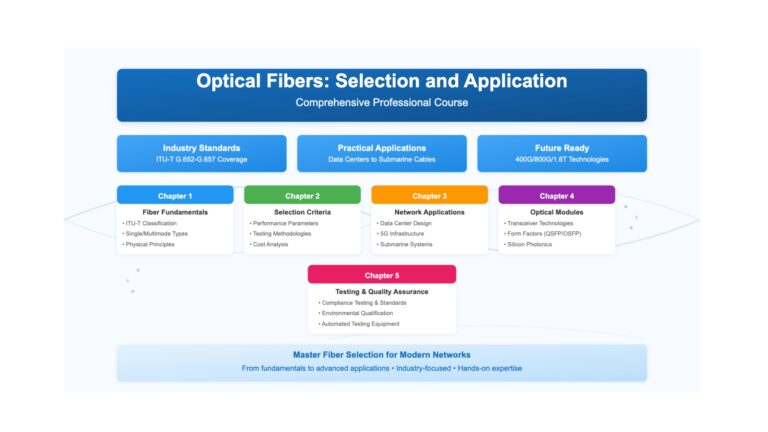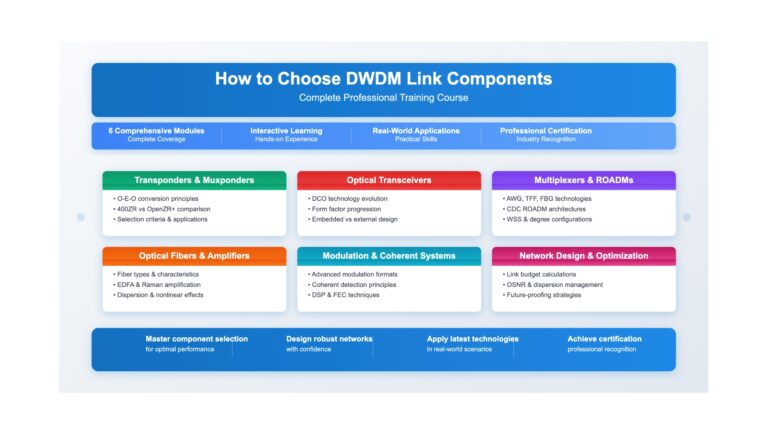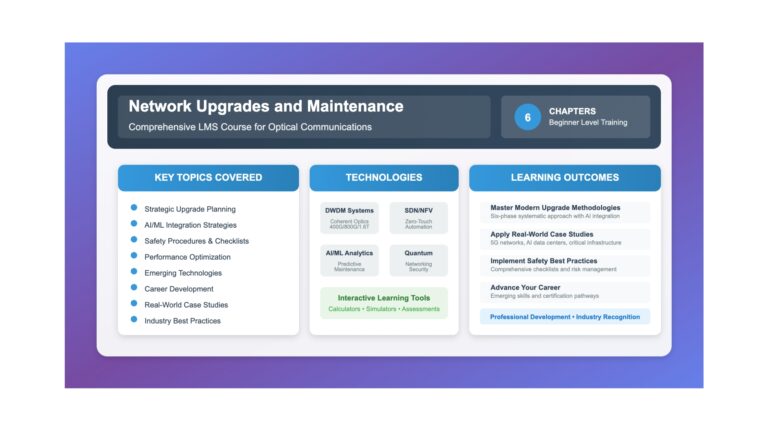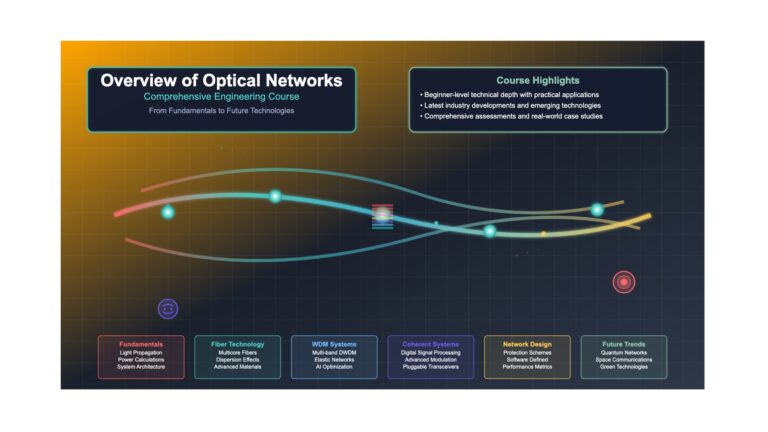Description
Curriculum
Instructor
Learning Objectives
- Define multi-tenancy in the context of optical networking and distinguish it from traditional dedicated infrastructure
- Analyze the economic and technical drivers behind the adoption of shared optical networks
- Evaluate the architectural requirements for implementing isolation and security in multi-tenant optical systems
- Assess the benefits and challenges of spectrum sharing technologies in modern telecommunications
- Compare different deployment models for multi-tenant optical networks and their use cases
Curriculum
- 6 Sections
- 57 Lessons
- 10 Weeks
Expand all sectionsCollapse all sections
- Chapter 1: Introduction to Multi-Tenancy in Optical Networks8
- Chapter 2: Spectrum Sharing Technologies and Implementation9
- 2.12.1 Evolution from Fixed Grid to Flexible Grid
- 2.22.2 Bandwidth Variable Transponders (BVTs)
- 2.32.3 Reconfigurable Optical Add-Drop Multiplexers (ROADMs)
- 2.42.4 Routing and Spectrum Assignment (RSA) Algorithms
- 2.52.5 Spectrum Defragmentation Techniques
- 2.62.6 Multi-Band Operation and Expanded Spectrum
- 2.72.7 Performance Monitoring and Quality of Transmission
- 2.8Chapter Summary
- 2.9Self-Assessment Questions
- Chapter 3: Software-Defined Optical Networks (SDON) Architecture9
- 3.13.1 SDN Principles in Optical Networks
- 3.23.2 Multi-Domain SDN Controller Architecture
- 3.33.3 Northbound APIs and Service Abstraction
- 3.43.4 Southbound Protocols and Device Management
- 3.53.5 Path Computation Engine (PCE) Architecture
- 3.63.6 Service Orchestration and Lifecycle Management
- 3.73.7 Performance Monitoring and Analytics
- 3.8Chapter Summary
- 3.9Self-Assessment Questions
- Chapter 4: Network Virtualization and Orchestration9
- 4.14.1 Network Function Virtualization (NFV) in Optical Networks
- 4.24.2 Network Slicing for Multi-Tenancy
- 4.34.3 Virtual Optical Networks (VONs)
- 4.44.4 Container-Based Network Functions
- 4.54.5 Service Orchestration Frameworks
- 4.64.6 Multi-Domain Service Orchestration
- 4.74.7 Performance Evaluation and Optimization
- 4.8Chapter Summary
- 4.9Self-Assessment Questions
- Chapter 5: Security and Performance Isolation10
- 5.15.1 Multi-Tenant Security Threat Landscape
- 5.25.2 Defense-in-Depth Security Architecture
- 5.35.3 Optical Layer Encryption Technologies
- 5.45.4 Performance Isolation Mechanisms
- 5.55.5 Quantum-Resistant Security Measures
- 5.65.6 Security Monitoring and Incident Response
- 5.75.7 Compliance and Audit Requirements
- 5.85.8 Security Performance Trade-offs
- 5.9Chapter Summary
- 5.10Self-Assessment Questions
- Chapter 6: Advanced Topics and Future Trends12
- 6.16.1 Technology Evolution Timeline
- 6.26.2 Artificial Intelligence and Machine Learning Integration
- 6.36.3 Space-Terrestrial Optical Network Integration
- 6.46.4 Next-Generation Optical Technologies
- 6.56.5 Quantum Technologies in Optical Networks
- 6.66.6 Sustainable and Green Networking
- 6.76.7 6G and Beyond Wireless Integration
- 6.86.8 Economic and Business Model Evolution
- 6.96.9 Standardization and Interoperability Roadmap
- 6.106.10 Strategic Technology Adoption Framework
- 6.11Chapter Summary
- 6.12Self-Assessment Questions
Admin

21 Students36 Courses
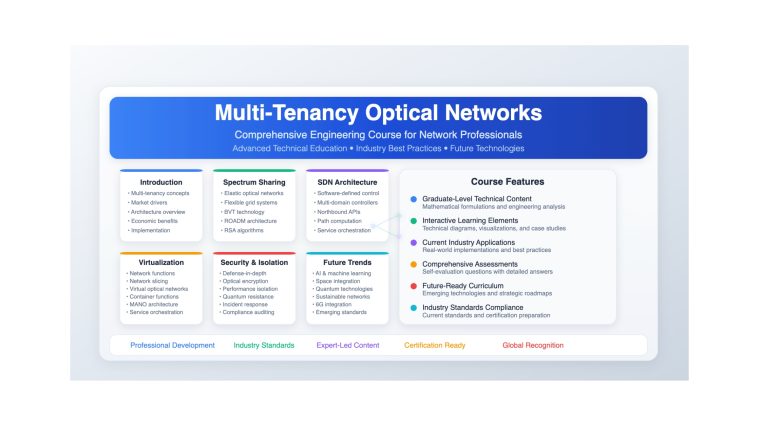
Free
0 student
57 lessons
Language: English
0 quiz
Assessments: Yes
Skill level All levels
Courses you might be interested in
Fiber Optics & Components
Learning Objectives Understand the fundamental principles of optical fiber communication and light propagation Classify different types of optical fibers based on ITU-T standards and industry specifications Analyze the key physical...
-
41 Lessons
Free
DWDM Technology
Learning Objectives Understand the fundamental principles of Dense Wavelength Division Multiplexing (DWDM) Analyze the role and functionality of transponders in DWDM networks Compare different transponder types and their applications Evaluate...
-
49 Lessons
Free
Network Automation
Learning Objectives Understand the fundamental principles and drivers of network upgrades in modern optical communications Analyze capacity requirements, technology advancements, and cost-benefit considerations for upgrade decisions Evaluate compatibility, interoperability, and...
-
47 Lessons
Free
DWDM Technology
Learning Objectives Understand the fundamental principles of optical communication and light propagation Analyze the electromagnetic spectrum and optical window characteristics for fiber transmission Compare optical communication advantages over traditional electrical...
-
61 Lessons
Free


